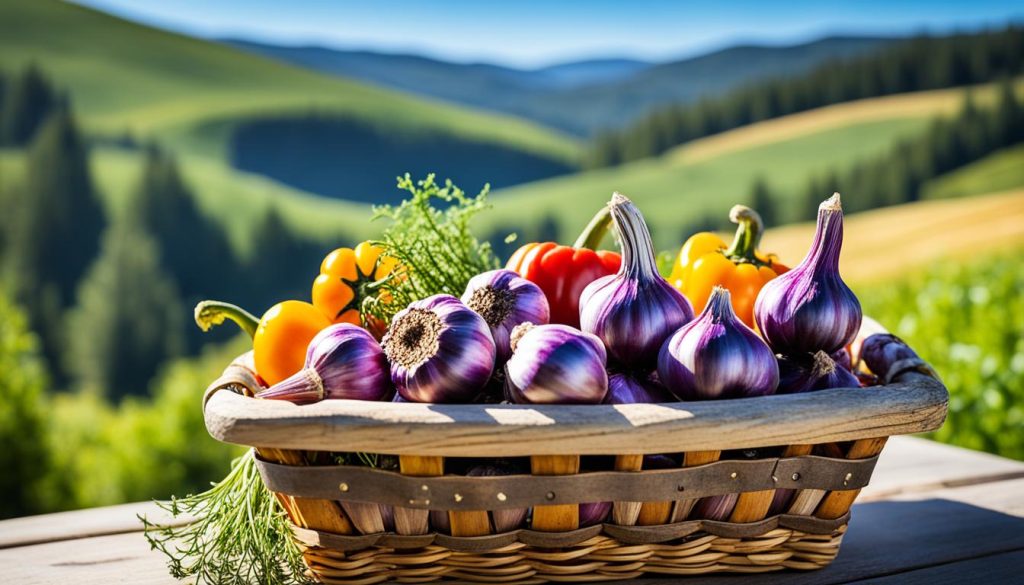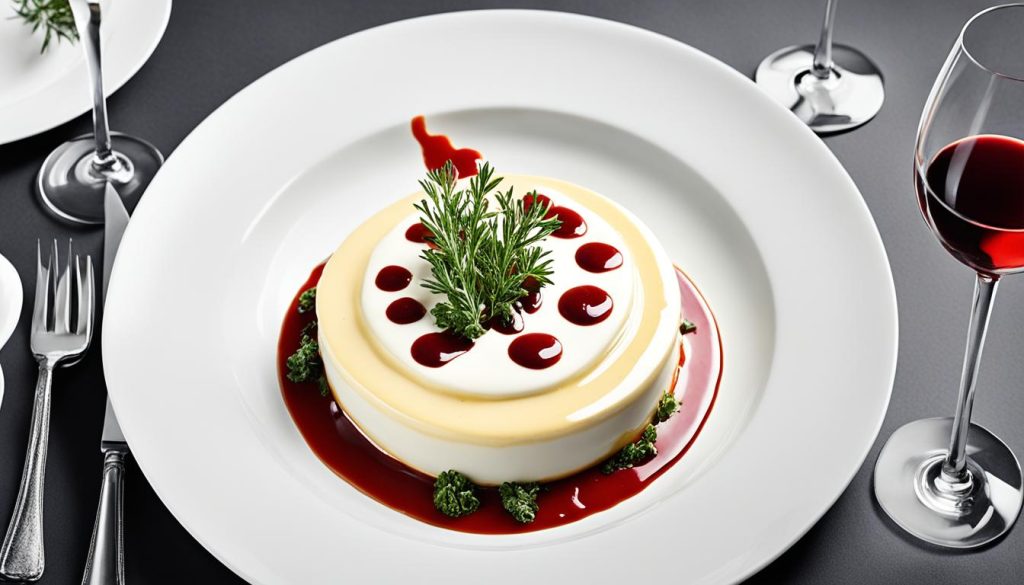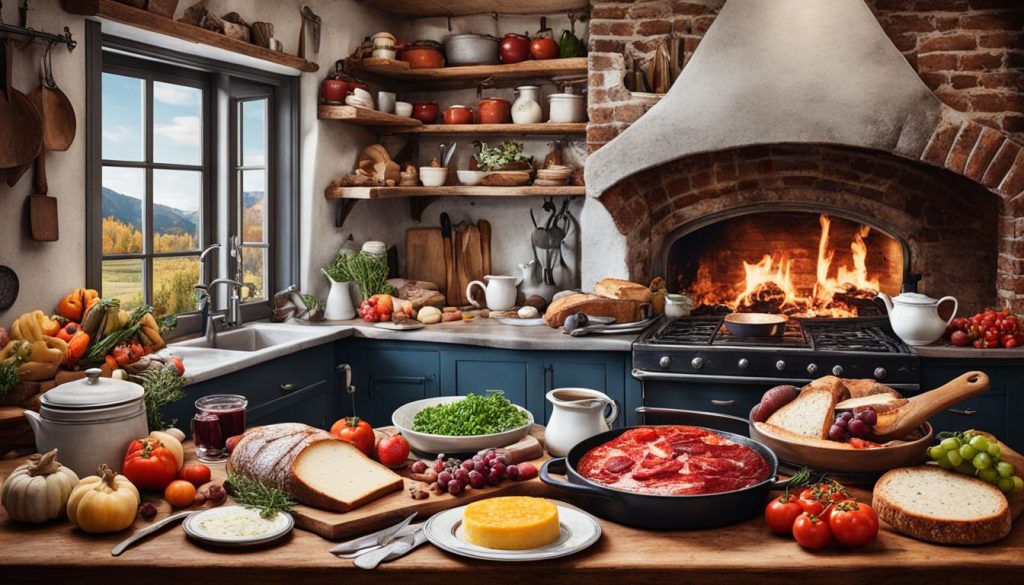French cuisine is famous for its combinations of flavours. It is so special, it’s on UNESCO’s intangible heritage list. Starting with wine and cheese, like brie and Burgundy, enhances this culinary adventure.
- Introduction to French Cuisine and Local Goods
- The Essentials for Creating Authentic French Dishes
- Exploring Classic French Recipes for Your Home Kitchen
- Purchasing Local Goods and Enjoying French Cuisine at Home
- The Role of Fresh and Local Produce in French Cooking
- The Art of French Baking: Bread and Pastries
- Wine and Cheese Pairings: A Taste of France
- Mastering French Sauces and Their Importance
- A Guide to French Regional Specialities
- Bringing the French Bistro Experience to Your Dining Table
- Source Links
But there’s more to French cuisine than just cheese. With classic dishes, your kitchen turns into a place of culinary art. Dishes like soupe à l’oignon and coq au vin showcase fresh, local ingredients.
Key Takeaways
- French cuisine features simple, rich flavours and has achieved global recognition.
- Wine and cheese pairings are a cornerstone of the French culinary experience.
- Classic French dishes like soupe à l’oignon, coq au vin, and tarte Tatin can be recreated at home.
- Using local produce is essential for achieving authentic French cooking at home.
- The kitchen becomes a space to celebrate French gastronomic legacy with the right selection of local goods.
Introduction to French Cuisine and Local Goods
French cooking is known for its deep roots in the nation’s culture. It shines through its selection of fresh, local ingredients. The balancing of time-honoured recipes with quality produce is key.
The Heritage and Charm of French Culinary Art
Central to French culinary practice is the cuisine du potager and cuisine du marché. These concepts value the closeness to where food is grown, ensuring ingredients are always fresh. Their tradition continues with a love for local veggies, artisan bread, and dairy like cream and cheese. French food, known for its careful preparation, is a symbol of elegance and tradition.
The Importance of Local Goods in French Cooking
Using local produce is crucial in French food traditions. It brings out the best in flavours while ensuring ingredients are fresh. It also means supporting local farmers and promoting sustainability. Today’s French chefs keep the authentic flavours alive by choosing seasonal, local ingredients.
The Essentials for Creating Authentic French Dishes

To make authentic French dishes, start by knowing the basics of French cooking. You’ll need the right kitchen tools and ingredients. True French cuisine comes from using specific items and traditional methods.
Must-Have Ingredients for French Cooking
Some key ingredients are essential for any French chef:
- Butter and Olive Oil: Butter is key in the north, and olive oil is used in the south.
- Garlic and Onions: These add layers of taste to many dishes.
- Dijon Mustard: A must-have for dressings and marinades.
- Herbs: Thyme, rosemary, and tarragon boost flavours.
- Fleur de Sel: This fine sea salt from Brittany enhances dishes.
- Quality Wine: It’s great for cooking and drink pairings.
- Homemade or Artisan Stock: It’s the base for sauces and stews.
Using these ingredients properly, your dishes will capture the essence of French cuisine.
Essential Kitchen Tools for French Cuisine
For French recipes, the right equipment is crucial. Here’s what you need:
- Cast Iron Cookware: Perfect for slow-cooked meals.
- Casserole Dishes: A must for baking and serving.
- Mandolines: They ensure vegetables are sliced evenly.
Having these tools and ingredients means you’re ready to tackle French dishes. Remembering these essentials will allow you to make meals that are both tasty and authentic.
Exploring Classic French Recipes for Your Home Kitchen
French food gives you a rich collection of classic recipes. They make your kitchen a place of culinary joy. These dishes show the beauty and ease of French cooking.
Top 10 French Dishes You Must Try
Here are the top 10 French dishes to explore:
- Soupe à l’oignon – A rich onion soup with cheese and croutons on top.
- Coq au vin – Chicken cooked in wine with mushrooms and garlic.
- Cassoulet – A long-cooked mix of meat and white beans.
- Bœuf bourguignon – Beef slow-cooked in red wine with veggies and herbs.
- Chocolate soufflé – A light yet indulgent chocolate dessert.
- Flamicke – An enticing leek pie.
- Confit de canard – Duck legs cooked slowly in their own fat.
- Salade Niçoise – A bright salad with olives, tuna, and anchovies.
- Ratatouille – A mix of tomatoes, zucchinis, and eggplants.
- Tarte Tatin – An apple tart that’s served upside-down.
Easy French Recipes for Beginners
Starting with simple dishes is great for beginners. Many French recipes are easy to follow, even for new cooks. They come with clear steps and tips from famous chefs. This makes French cooking at home welcoming for everyone.
Purchasing Local Goods and Enjoying French Cuisine at Home

Learning to cook French food starts with finding local French ingredients. One good idea is to check out local farmers’ markets. Here, you can find fresh produce that’s perfect for French cooking.
Try visiting artisanal bakeries for fresh baguettes and local butchers for quality meats. Using these ingredients makes your food taste better. It also helps local businesses and cuts down on food miles.
Finding sourcing local produce is more than just shopping. It’s about connecting with where your food comes from. Buying locally means you get fresher, tastier ingredients. This fits with the French way of cooking, which values using the best produce to make meals tasty.
- Visit local farmers’ markets for fresh produce.
- Buy bread from artisanal bakeries.
- Source meats from local butchers.
- Enjoy the unique flavours of locally sourced ingredients.
The Role of Fresh and Local Produce in French Cooking
Fresh and local items take French dishes to the next level. They make meals tasty, healthy, and genuine. By using local ingredients, home cooks bring the essence of French recipes to life. Here’s how local produce can upgrade your cooking:
Benefits of Using Local Ingredients
Local ingredients have many advantages. Freshness stands out because local produce is picked when perfectly ripe. This gives better taste and more nutrients. Enjoying meals becomes more delightful. It also backs local farmers and their communities.
Plus, local ingredients keep regional food ways alive. They ensure the survival of special flavours and skills across generations.
Sourcing Quality Local By choosing
It takes effort to find great local French produce but it’s worth it. Building connections with local growers opens up knowledge about the best seasonal produce. Weekly farmers’ markets are a treasure trove for fresh ingredients. They let you select personally and support local, small producers.
seasonal items, your cooking will really reflect French culinary soul. Your dishes will be rich in flavour and nutrition.
The Art of French Baking: Bread and Pastries

French baking is a fun way to dive into French cuisine. It focuses on two main parts: making bread and pastries. Both are traditional and need skill and patience to master.
Creating Authentic French Bread at Home
Learning to bake French bread means getting its special features right. This includes a crispy outside and soft inside. Favorites like baguettes and boules are good to start with.
To get that perfect bread, careful fermentation and handling are key. Also, choose the best flour you can. Giving the dough enough time to rise is another secret for great bread.
Baking Delicious French Pasties
French pastries need care and attention to detail. Think of croissants’ flaky layers or éclairs’ creamy middles. The way you lay the pastry and the baking temperature are crucial.
With some practice and solid recipes, you can make these pastries at home. It’s like bringing a piece of French patisserie into your own kitchen.
Wine and Cheese Pairings: A Taste of France
Wine and cheese are key to French food culture. Finding the right match can transform a meal into something special. Whether it’s for a dinner party or a cosy night in, learning to pair French cheese and wine is a skill you’ll love.
Popular French Cheeses to Try
France is famous for its diverse cheeses, each unique in taste and texture. Here are some you should try:
- Brie: A soft cheese from Île-de-France, it has a creamy texture and mild taste. It goes well with red and white wines.
- Camembert: From Normandy, Camembert offers a stronger flavour. It’s great with fruity red wines.
- Roquefort: Called the “King of Cheeses,” Roquefort is a tangy blue cheese. It pairs well with sweet wines.
Pairing French Wine with Your Meals
Balance is crucial for a perfect wine pairing. The cheese should enhance, not dominate, the wine’s taste. Here are tips for pairing French wines and cheese:
- Red Wines: Full-bodied reds like Bordeaux or Burgundy go well with strong cheeses such as Camembert and Roquefort.
- White Wines: Light whites like Sauvignon Blanc and Chardonnay match soft cheeses like Brie, adding a fresh contrast.
- Sweet Wines: Dessert wines like Sauternes complement blue cheeses like Roquefort, with sweetness balancing the tanginess.
Using a French wine guide can help find the best matches, ensuring every sip and bite is a true French experience.
Mastering French Sauces and Their Importance

French cooking is famous for its tasty sauces. These sauces are key in making any dish stand out. By learning to make French sauces, you can turn basic ingredients into an exceptional meal.
Classic French Sauces to Elevate Your Dishes
There are several key sauces that form the basis of French cuisine. This includes:
- Béchamel: This white sauce is made from roux and milk. It’s the start for many other sauces.
- Velouté: A silky sauce made with roux and stock. It’s great with poultry, fish, or seafood.
- Holland
A Guide to French Regional Specialities
France has a rich variety of regional specialities. Each one highlights the local ingredients and cooking styles. Going on a tour of French regional food takes you through the country’s different areas and cultures. You can enjoy dishes like Provençal ratatouille and cassoulet from the South, each with its own story.
We will look at some iconic local French dishes. They really show what French regional cuisine is all about:
- Burgundy – Famous for its beef stews like ‘Boeuf Bourguignon’ and ‘Coq au Vin’.
- Alsace – Known for ‘Tarte Flambée’ and ‘Choucroute Garnie’, a great mix of sauerkraut and meats.
- Normandy – Offers tasty ‘Moules Marinières’ and the creamy ‘Chicken Normandy’.
- Provence – Well-known for ‘Bouillabaisse’ and the fragrant ‘Ratatouille’.
- Southwest France – Offers ‘Cassoulet’, a casserole with duck, pork, and beans.
By trying these dishes, you can bring French cuisine’s diversity to your kitchen. Each dish shares the story of its region’s history. They also let you enjoy real local French food at home.
Bringing the French Bistro Experience to Your Dining Table
Bringing a French bistro into your home is a fun way to enjoy French food. The charm of a French bistro lies in picking the right dishes and creating a cozy atmosphere. With these elements, any meal can feel like a special journey.
Creating a French-Inspired Menu
Building a menu that feels like a French bistro is important. Include classics like steak frites, moules marinières, and crème brûlée. Add a fresh baguette and a tasty salad for a full French experience. Remember, the key to French cooking is using fresh, high-quality ingredients.
Setting the Perfect French Bistro Atmosphere
To capture the bistro feel, start with the right lighting. Use candles or low lights to make it cozy. Background French music, such as chanson or jazz, enhances the mood. Elegant table settings with white linens and nice glassware will add the final touch. Together, these details will whisk you away to a charming French bistro.
Source Links












